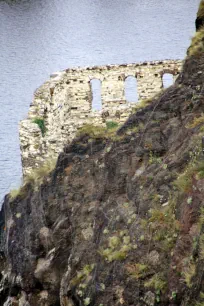Vyšehrad is the site of a large castle built in the tenth century on a rocky hill just south of Prague’s center. The castle was used as the royal residence until 1140 when the Bohemian rulers moved to the Prague Castle in Hradčany.



History
According to an old legend, Vyšehrad was founded by a Czech princess, Libuše, who later also founded the castle in Hradčany. Libuše married a farmer named Přemysl, starting the dynasty of the Přemysls, and settled in Vyšehrad.
Archeological research however revealed that the castle in Hradčany is actually older. Nonetheless, Vyšehrad was the preferred residence of the Bohemian rulers from its foundation in the tenth century until they moved to Hradčany in 1140.
The castle was still in use and even significantly fortified until the nineteenth century, when most of the buildings were razed. Only the ramparts and gates remain. Nonetheless, Vyšehrad still has some interesting sights.
Ramparts
The main entrance to Vyšehrad is at the seventeenth century Tábor Gate, which leads through the remains of the old fourteenth-century rampart, built by King Charles IV. The road then leads to the impressive Baroque Leopold Gate, also dating back to the seventeenth century. The immense ramparts left and right from the Leopold Gate were built in the eighteenth century. You can walk atop the ramparts, from where you have great views over Prague.
Vyšehrader Park
Just behind the Leopold Gate is a small circular Romanesque church, built in the eleventh century and known as the Rotunda sv. Martina. Further inwards, you find the Vyšehrader Park, once the site of a Romanesque palace. The park features several nineteenth-century sculptures created by Josef Václav Myslbek. These sculptures depict historical Czech figures such as Libuše and Přemysl.
St. Peter and Paul Church


Near the park is Vyšehrad’s largest building, the St. Peter and Paul Church. The church was founded in the eleventh century by Vratislav II, the first king of Bohemia. After the church was destroyed by fire in the thirteenth century, it was rebuilt in Gothic style. Its current look dates mainly from around 1902, when the two towers were added.


Cemetery of Honor
Adjacent to the church is a cemetery (Vyšehradský hřbitov) which since 1869 has been in use as the national cemetery of honor. Famous Czech citizens such as the musicians Smetana and Dvorák and poet Jan Neruda lie buried here.
Bath of Libuše
Not much is left of the original castle; the historic buildings were razed in the nineteenth century, since they had become redundant. The most visible remnant of the once large castle is the ruin of the Gothic Bath of Libuše, once the defensive bastion of the medieval castle.
Getting to Vyšehrad
The easiest way to reach Vyšehrad is by subway. After exiting the metro stop ‘Vyšehrad’, you cross the esplanade in front of the congress center. At the end, stairs lead to the Na Bucance street. Follow the street for two blocks, where on your right you’ll see the Tábor Gate, the western entrance gate to Vyšehrad.

